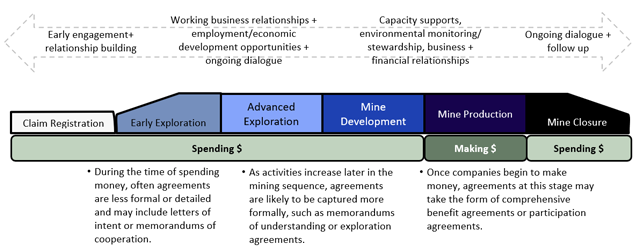Statement on community-proponent agreements
Learn about agreements between mining companies and Indigenous communities.
Agreements between mineral companies and Indigenous communities (sometimes referred to as “arrangements”) are not required to obtain regulatory approvals under Ontario’s Mining Act and are not regulated under the Act.
Ontario has a duty to consult with and, where appropriate, accommodate Aboriginal communities
Project proponents will often have a direct role in the consultation process as delegates of NDMNRF during advanced exploration and mine production, carrying out specific procedural aspects of consultation, as directed. This can create confusion where Crown consultation processes and community-proponent negotiations toward agreements may overlap in timing and subject-matter. NDMNRF has sought to reduce that confusion by clearly articulating its approach to regulatory decisions and consultation, and the processes it will conduct or direct in fulfilling that legal duty, in its implementation policy
Mineral industry proponents, Indigenous communities, and organizations across Canada have recognized the importance of engaging with one another throughout the mineral exploration and mine production sequence. Proponents have an interest in building relationships and community support for a project that regulatory approvals alone cannot provide — and Indigenous communities have an interest in supporting, participating in, and benefiting from, resource development activities. As a result, various forms of community-proponent agreements have emerged, particularly as mineral project activities increase in scale and scope.
NDMNRF does not have a role in negotiations that communities and proponents may pursue for their own relationship and business reasons. NDMNRF acknowledges the various policies, guides, and leading practices — created by industry and Indigenous organizations alike — that are available to assist proponents and communities as they build relationships. These all tend to emphasize engagement and finding mutual commitments that are proportional to the nature of the specific project and that are feasible for the project to sustain.
Community-proponent agreements – Proportionality and feasibility
There are many examples of successful and mutually beneficial working relationships between proponents and Indigenous communities across the province. These may or may not be reflected in formal, written agreements, often depending on the stage in the mining sequence the project has reached. As already noted, however, commercial agreements between proponents and communities are not required to obtain regulatory approvals under Ontario’s Mining Act and are not regulated under the Act. Accordingly, they are for proponents and communities to consider and potentially negotiate based on their own interests and perspectives. Nevertheless, the following comments may be helpful.
At the early stages of mineral exploration, proponents and communities often struggle to find a balanced approach to their commitments. Early exploration is a highly speculative endeavour , which requires significant investment and expenditure but produces no direct revenue stream to proponents. As a result, arrangements at this stage should be scaled in proportion to the nature of a project. Commitments that extend beyond the capacity of a project to support them can jeopardize investment in a project later on.
At later stages of the mining sequence, particularly mine development and production, more comprehensive benefit agreements — reflecting commitments that increase in scale relative to the project’s impacts and opportunities — have largely become common. NDMNRF acknowledges and supports this as a best practice.
Negotiations, at any stage, can be challenging and multi-facetted and depend on the communities, proponents, and projects involved. Regardless of specific circumstances, open and transparent communication about a project (such as how it is financed, what is feasible and what is not) can go a long way to advancing discussions, managing expectations and achieving a respectful working relationship. Being realistic and practical about the commitments appropriate at and proportional to different project stages is also critical.
NDMNRF is aware of a number of typical, practical and feasible elements at various stages of the mineral exploration and development sequence. These have been summarized in the graphic that follows (Figure 1).
Proportionality of agreements throughout the mining sequence
Figure 1. Agreements should ideally be proportional to the nature, scale and duration of the project and its potential impacts. They should not place an excessive burden on the proponent or undermine the feasibility of the project.
Footnotes
- footnote[1] Back to paragraph “Aboriginal communities” is the preferred term when referring to the Crown’s duty to consult, which flows from s. 35 of the Constitution Act, which uses the term Aboriginal. “Indigenous” refers to a broader cross-section of Aboriginal people, who may or may not have constitutionally protected rights triggering Crown obligations.
- footnote[2] Back to paragraph See Ontario’s Mining Act and regulations, as well as NDMNRF's Consultation Framework: Implementing the Duty to Consult with Aboriginal Communities on Mineral Exploration and Mine Production in Ontario.
